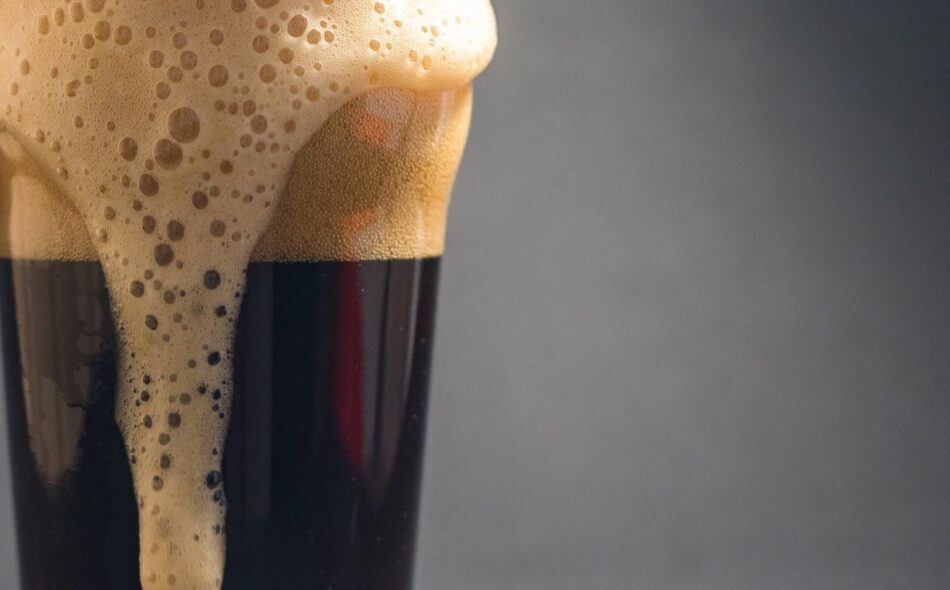Dark beer: Why we love this style
Dark beers are serious business. Like it says on the bottle, they are dark – sometimes almost black – and feature a heavily roasted flavour profile. Dark favourites like stout and porter cater to the drinker who demands a strong, malty, full-bodied beer. The taste is rich, with hints of coffee, chocolate and liquorice. Although they’re often considered an independent beer category, dark beers use top-fermenting yeasts and, as such, belong to the ale family.
Because much of the beer we drink in this sunburnt country is lighter coloured lager, dark beers can be unfamiliar and intimidating. But the good news is many Darker Beers have depth and flavour as well as that thirst-quenching ability we Aussies demand from our beer, so there’s no need to count them out.
Flavours and favourites
The most common styles of dark beer are stout and porter.They are so close that many people have trouble telling them apart. So what’s the difference? You might need to order another round, because it’s a complicated story.
The original porter recipe is thought to mimic the popular practice of combining beers, usually brown and mild ales. Porter was originally an English style of beer popular with the masses in the UK and US in the years before lagers appeared and ales were fashionable.
After the demise of porter due to the introduction of pale ale in the UK and prohibition in the US, many believe stout took its place. Both beers are dark with a malty flavour, but while porter has hints of sweetness from caramel and molasses, stout is darker, dryer, stronger and richer. It boasts a white creamy head that often lasts until the glass is empty.
Irish stouts are still some of the most popular dark beers, none more so than Guinness, of course. This rich, dry, almost black brew has a distinctive white creamy head and is enjoyed in pubs around the world.
How to drink dark beer
Hearty beers go well with hearty foods, so dark beers are the perfect accompaniment to red meat and rich stews. The coffee and chocolate flavours also mingle well with cakes and desserts with the same ingredients. And don’t forget one of the classic beer pairings: oysters and Guinness. But for many dark beer devotees, the beer is a meal in itself.
Dark beers are traditionally served in a pint glass. To pour, tip the glass on a slight angle and, as it fills, place it on a flat surface. Stop pouring when the glass is almost full to let the beer settle. Once the beer turns black, fill the glass to the top.
If you like Lager beer you might also like: Dunkel Weissbier, a brown wheat beer with a taste that’s both fruity and bitter.
Did you know?
A porter beer was originally called an ‘entire’, owing to its mix of various beer styles. The name ‘porter’ became popular because the porters of London’s hotels and hospitals were said to be partial to the brew.
There is a 9000-year lease on the Guinness St. James’s Gate Brewery, Dublin. It was signed back in 1759. Beer is mostly made up of water, and Dublin’s mineral-rich hard water is perfect for making stouts like Guinness.
Background of the brew
Up until the 18th century, when brewers started making pale ales, pretty much all beer was dark beer. Dark beer’s colour and bracing flavour is a result of it being made with heavily roasted malts and barley. In recent centuries, the two most popular varieties have been porter and stout.
Apparently the first porters were created by mixing three different types of dark beer together. Supposedly, London transport workers, known as porters, were big fans of the brew – hence the name. Over time, brewers started making stronger porters. These were originally called stout porters before becoming known simply as stouts. Find out more about the history of dark beers.
In 1759 a far-sighted Irishman called Arthur Guinness signed a 9000-year lease on an idle Dublin brewery and set about taking stouts to a whole new level. Guinness, a dry stout, has its now world-famous flavour because Arthur and his successors amped up the roasted barley.
Dark: History of the style
Porters as thick and full bodied and stouts swimming in roasted barley. The taste of dark beer can range from sweet and chocolatey to dry and heavy. Ireland is home to the most famous of stouts – Guinness, of course – but you can find dark beers all around the globe, such as in Germany, Belgium and America. Let’s take a look back at the history of these bold, full-bodied beers.
Porters and stouts
The English Porter is probably the most important of the dark beers and is the great-grandfather of the stout we know and love today. Porters and stouts are traditionally made from roasted malt or barley.
The first mention of porter is disputed among beer historians, who also dispute its original composition. However the dark, toasty beverage came into vogue from about the 1720s.
One favourite story about the porter’s early composition – though it’s been widely denounced as untrue – came from 19th century English writer John Feltham, who said it was a combination of ale, lager and twopenny (the colloquialism for the strongest beer available, which cost a tuppence for a quart). In the 18th century, probably due to the Napoleonic War taxation on hops, porters became more affordable (because they’re made predominantly from brown malt) and their popularity exploded with the cart pushers of London, also know as ‘porters’.
But where does stout come into it? Depending on who you talk to’ a porter is a stout. Originally, the adjective stout meant “proud” or “brave”, but eventually it took on the meaning of “strong” from the 14th century onwards and was applied to heavier beers from around the 1670s. It was possible to find stout pale ales back in the day. However, as time progressed, stout came to apply almost exclusively to porters.
Probably the most famous stout of them all is Guinness Draught , brewed at St James’s Gate Brewery since the 18th century.
How dark malt is made
The colour of a beer is determined by one of four main ingredients: malt. The most common type of malt grain used in today’s brewing process is barley. The barley is soaked in water until it begins to sprout and is then heated, or “kilned”. The colour and flavour of the beer comes down to how long the barley malt is kilned for. Dark beers are made using deeply roasted barley, which contributes to the smoky rich flavour that is common to this style.
The main types of dark beer include:
Dry stout: Such as Guinness – the template for all stouts.
Milk stout: Such as Mackeson Stout – brewing adds lactose for sweetness.
Imperial stout: Such as Courage Imperial Russian Stout – high alcohol content, usually over 9 per cent.
How dark malt is made
Yeasts can either operate at cool temperatures, known as a bottom fermenting, for lager, or at warmer temperatures, known as a top fermenting, for ale. Ales can range in colour from amber through to deep browns and reds. Brown ales use a brown malt.
Serving Dark Beers
There’s no point chilling a dark beer too much; 8-12ºC is the perfect serving temperature. While you’ll probably be served them in a standard beer glass at a pub, ideally you want to be using a brandy snifter. That way your nose can delight in those alluring chocolate, coffee and roasted malt aromas.
Dark and brown ales, as well as the term porter, were referenced in The London and Country Brewer journal during the 18th century, but they appeared to have died out. Until, that is, being revived in the late 19th century when a London brewer named Mann introduced a beer bearing his own name.
The darker-style ale only became widely brewed in England during the 1920s, while North American brown ales trace their heritage to American home-brewing adaptations of Northern English beers. Dark lagers, which include hops and roasted malt, are popular in Germany and have been around since the 16th century, when the Reinheitsgebot regulated the production of German beers.
Dark beers vary widely from stouts and porters to ales and lagers. So try out a beer like Monteith’s Barrel Aged Porter , a fine representative of the style.
Going dark
If you’d like to explore some of the lesser-known dark beers- a velvety rich Russian Imperial Stout- ideally served in the style of a short black at the end of a meal- is an unforgettable experience.
In recent times Belgian brewers have been creating dark beers with intriguing spicy and floral flavours. But if you want to kick it old school- Leffe Brune- brewed by Belgian monks since 1240, is a dark beer you want to cross off your alcohol-imbibing bucket list.
Finding the perfect food to match dark beer
What’s the difference between porter and stout? For the purposes of brevity, porter was the name given to a dark ale that was hugely popular in the 18th and 19th Century and “stout porters” originally described stronger versions, before becoming, simply, stout. Today they share much in common: pouring dark brown or black and possessing roasty, chocolate and coffee-like characteristics. You can get imperial versions of both, which are higher in alcohol, fuller in body and more complex.
You may also be interested in brown and dark beers. Somewhat confusingly, beers that bear the name “dark ale”, like those from White Rabbit and Coopers, aren’t particularly dark. Alongside brown ales, they offer a gentle introduction to the world of darker, maltier beers, with sweeter flavours and aromas of caramel, toffee, chocolate and nuts.
Belgians traditionally view beer on the dining table the way most other Western cultures view wine, and many of the brews that originate there are wonderful food beers: fruity, malty, spicy and complex. Belgian strong dark ales, which can nudge into wine territory in terms of alcohol content, are particularly enjoyable with food (or simply savoured by a log fire).
Pairing Dark Beer with Food
Brown and dark beers: These versatile beers are suitable for pairing with grilled or smoked meats, while their sweetness can cut through spicy dishes too. The nuttier browns work a treat with nuttier cheeses, like aged Gouda. Try the White Rabbit Dark Ale and the Cavalier Brown Ale.
Porter and stout: Believe it or not, stout and oysters is a tried and tested classic – try it! For something more seasonally appropriate, try pairing stout or porter with hearty fare such as BBQ ribs or brisket, roasted or smoked meats, or a classic beef pie. Stronger stouts go well with chocolate and you can even add a stout into your cooking! Try the Chocolate Stout Cake.
A glass of Imperial Stout and a wedge of aged or blue cheese is a match made in heaven. Try Wicked Elf Porter, the Sierra Nevada Porter, the Coopers Extra Stout Stubbiesor the Nail Oatmeal Stout.
Belgian strong dark ales: The Classic match is carbonnade Flamande, a Flemish beef stew cooked with the beer itself, but these beers also work with stews, steak and gam, as well as chocolate and strong cheese. Try the Chimay Blue and the La Trappe Quadrupel.
Next time, whether you’re cooking a classic chicken dish or your taste buds are craving a rich dessert, consider a dark beer as your beverage of choice.

